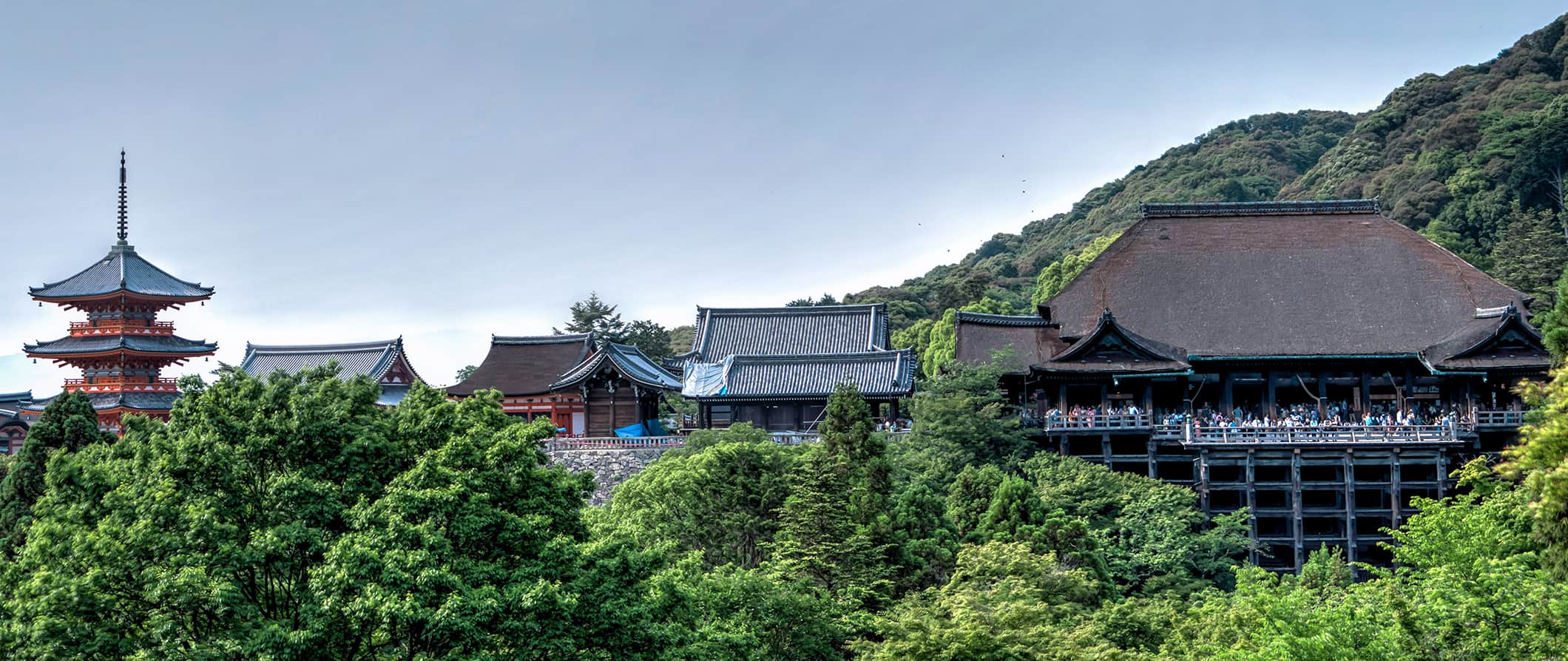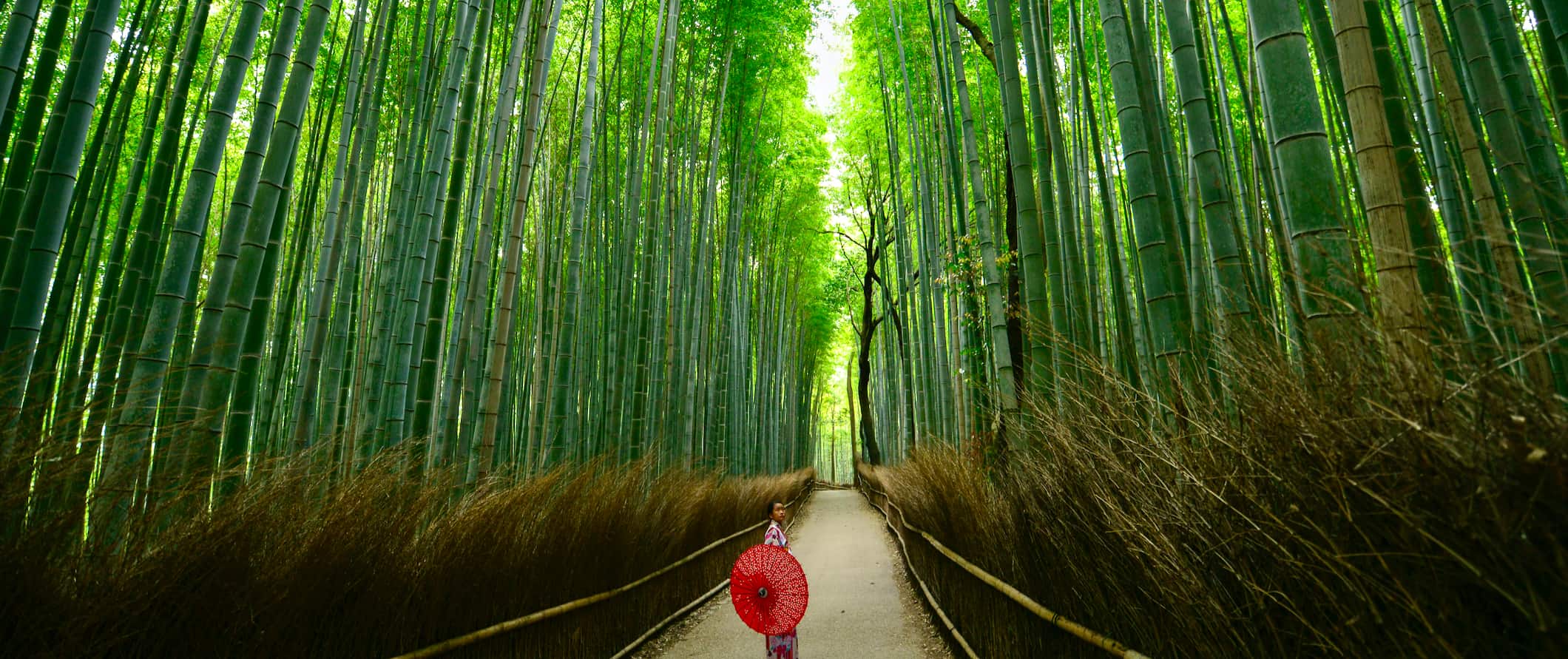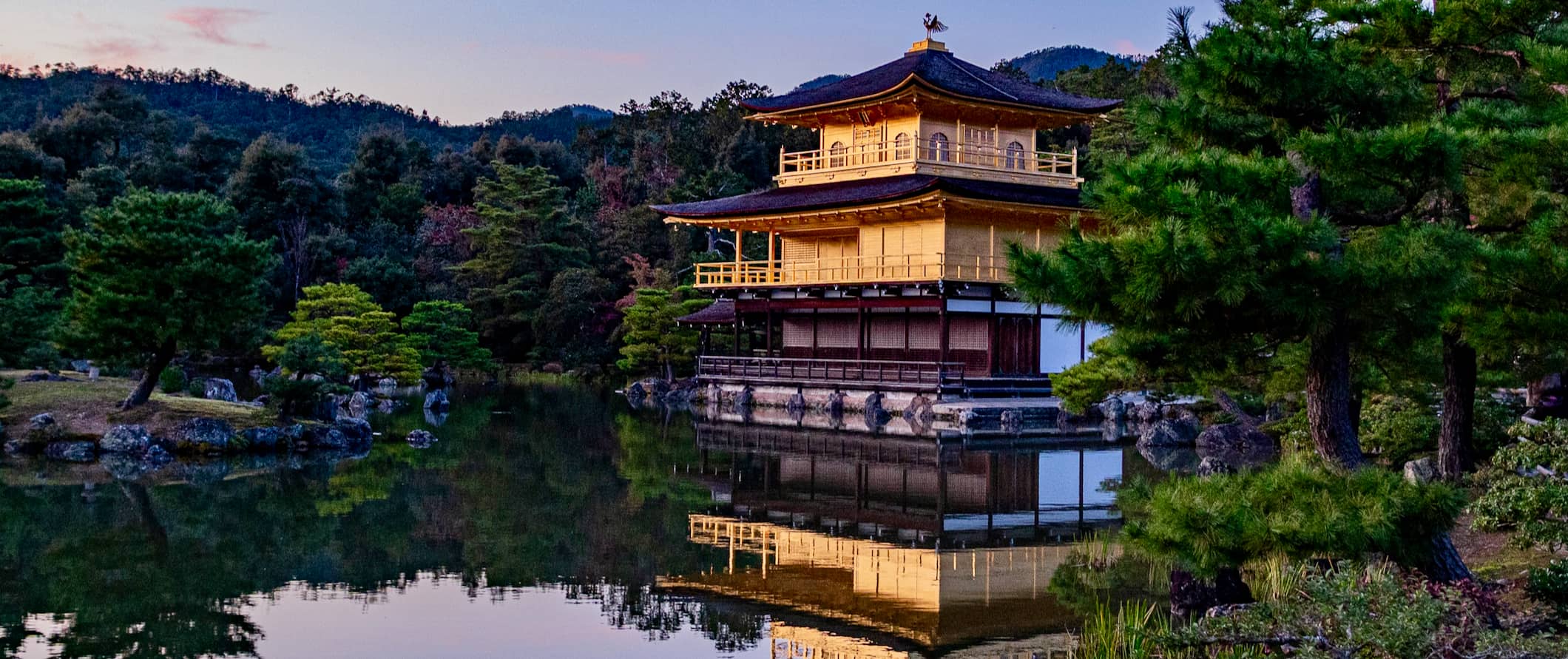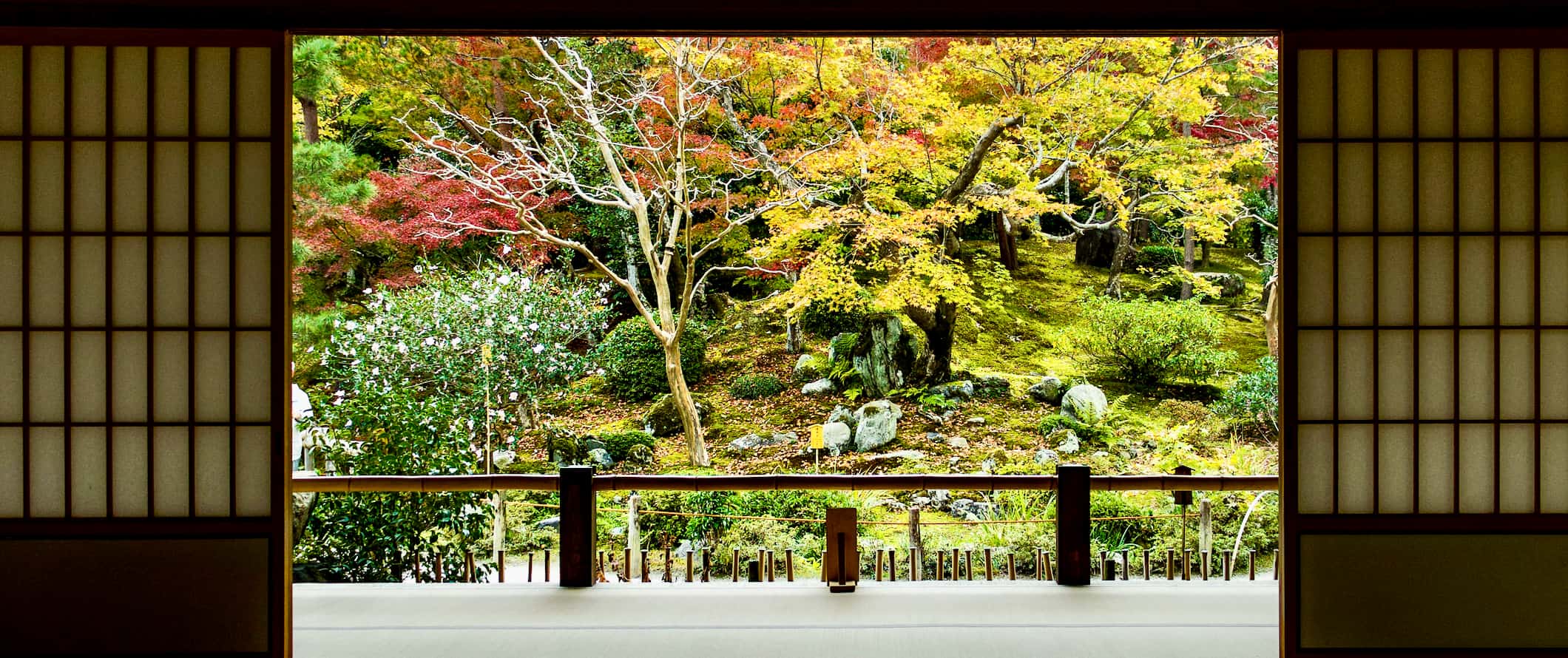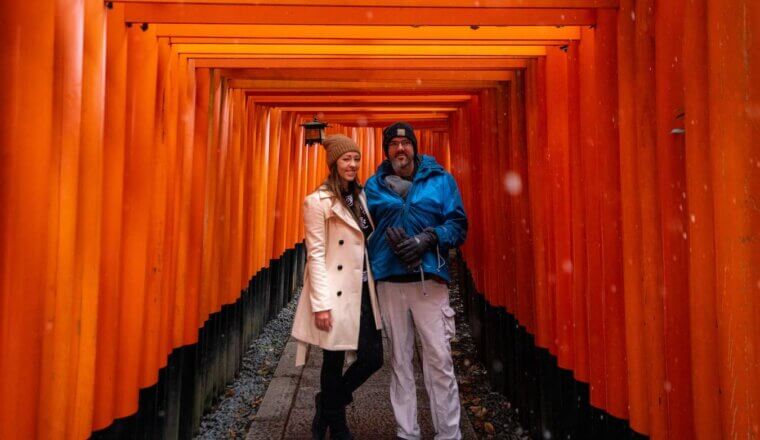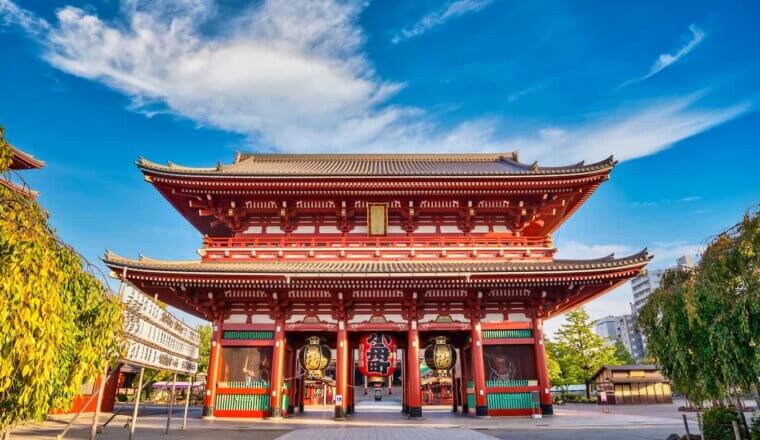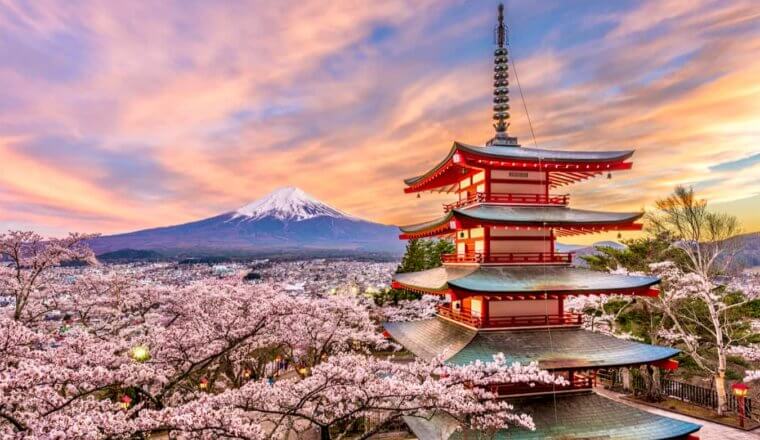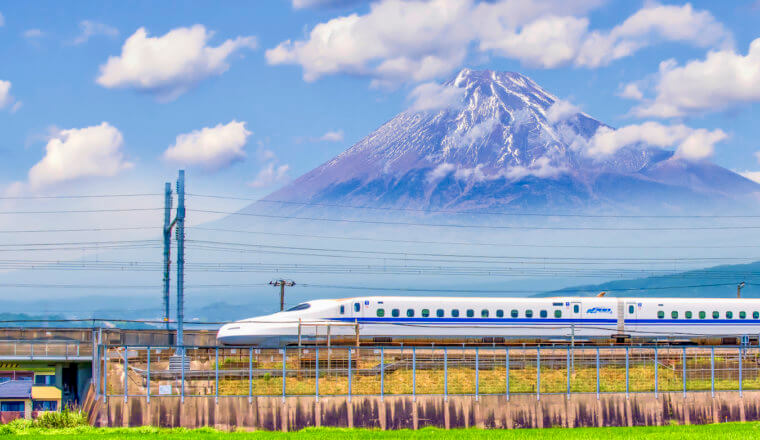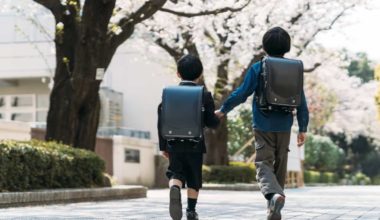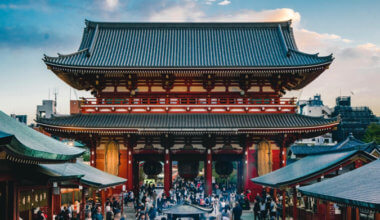Kyoto is one of the most gorgeous places in all of Japan. Surrounded by mountains, it boasts countless Zen gardens, Buddhist and Shinto temples, hiking trails, and sake distilleries, as well as some seriously tasty food. I loved wandering around, popping into temple after temple, admiring the wide array of gardens, and meandering through the bamboo forest.
It lives up to all the hype you’ve heard.
Visiting Kyoto is on everyone’s to-do list (both foreigners and Japanese come here), so expect crowds, especially during peak season. But the city is worth the throngs (and I have plenty of tips to help you avoid them). I’d definitely recommend spending at least three days here.
This travel guide to Kyoto can help you plan your trip and save some money.
Table of Contents
Top 5 Things to See and Do in Kyoto
1. Visit Gion
Gion is the famous geisha district. Take a stroll around the area and see ochayas (teahouses where geishas entertain), small shops, and many traditional restaurants. Here you’ll find a well-preserved district filled with classical architecture and design. Take a walking tour of Gion to learn even more about this historic area and geisha culture. (Note that you can’t take photos on the narrow private streets in Gion due to too many tourists gawking at and bothering geishas as they go about their business.)
2. Check out Heian Shrine
This Shinto shrine is one of the most popular and prized in the country. Built in 1895 on the 1100th anniversary of the establishment of Kyoto as Japan’s (former) capital, the main buildings in the complex are modeled after the original imperial palace. There is a massive torii gate at the entrance, and the shrine has a rather bright and ornate exterior that makes it stand out from the lush trees and gardens that surround it. If you’re here during cherry blossom season (late March-early April), it’s one of the best places in town to see them. The shrine is free, but the garden has an entrance fee of 600 JPY.
3. Day trip to Nara
Nara is a UNESCO World Heritage Site and home to over 1,300 “wild” deer that freely roam Nara Park. The Japanese consider them messengers of the gods, and there are places selling deer crackers all around the park so you can feed them by hand. Be sure to also visit the world’s largest wooden building, Todai-ji, which dates to the eighth century and was reconstructed in the 1700s. Note: Keep an eye on your things while in the park, as the deer will not hesitate to eat anything in your hands (including your own food, paper maps, etc.).
4. See Kinkaku-ji (The Golden Pavilion)
Officially known as Rokuon-ji, this is a Zen Buddhist temple that is part of Kyoto’s collective UNESCO World Heritage Site. There has been a temple here since the late 14th century, though it has been rebuilt several times (first in the mid-15th century and then again in the 1950s). The top two floors are entirely covered in gold leaf (hence its name, the Golden Pavilion). I think it’s one of the most beautiful temples in Kyoto. Admission is 400 JPY.
5. Explore Arashiyama (The Bamboo Forest)
Located near the famous Tenryu-ji temple, it’s a nice spot to walk around and get lost in. It’s not that big, but there are some hidden areas to explore. Since the forest is super popular (you’ll see a lot of school groups here too), arrive before 9am if you want to enjoy it without the crowds. It’s free to enter. You can also visit the very beautiful Okochi Sanso Garden. It costs 1,000 JPY and is well worth the price, especially since hardly anyone goes there.
Other Things to See and Do in Kyoto
1. Tour Nijo Castle
Nijo Castle was built in 1603 for Tokugawa Ieyasu, the first shogun of the Edo period. It later became an imperial palace before opening to the public. The castle spans 170 acres and features serene Zen gardens, intricate interior artwork, and a defensive moat. It is a popular tourist attraction, so it’s best to arrive early in the morning, before the crowds. The entrance fee is 800 JPY, plus an additional 500 JPY to enter Ninomaru, one of the two palaces within the castle. English audio guides (which I recommend) are 500 JPY.
2. Visit the Kyoto Gyoen (Imperial Palace Park)
This palace, which dates to 1855, is where the imperial family and court nobles resided until 1868, when the capital was moved from Kyoto to Tokyo. While you can’t enter any of the buildings, you’re free to look around and explore as much as you want (which is rare, as guided tours here used to be mandatory). There’s a huge garden surrounding the palace that is also nice to wander around too.
3. Walk around Higashiyama
This historic district is one of the oldest and best-preserved sections of the city, home to the eighth-century Kiyomizudera temple (one of the most famous in all of Japan). Spend an afternoon on the east side of the Kamo River and walk along its narrow historic streets, lined with traditional wooden buildings with small shops selling specialties, such as Kiyomizu-yaki pottery, okashi (candy), pickled foods, handicrafts, and other souvenirs. Another nice place to stroll in this neighborhood is the Philosopher’s Path, which follows a cherry-tree-lined canal that’s beautiful and meditative even when the blossoms aren’t in season.
4. Visit Ryoan-ji Temple
This was my favorite of all the temples that I saw in Kyoto. Built in the 15th century, this Zen shrine is a UNESCO World Heritage Site and features a mausoleum that houses the remains of seven emperors across Japan’s history. The traditional rock and sand garden, considered one of the best in the country, is immaculately kept and a stunning display of Buddhist art and philosophy. Admission is 500 JPY per person.
5. See more temples and shrines
Kyoto has over 1,600 Buddhist temples and 400 Shinto shrines, many of which form the collective UNESCO site, Historic Monuments of Ancient Kyoto. Devote some time to temple-hopping, though of course you won’t be able to see them all!
The main temples include the aforementioned Ryoan-ji with its famous rock garden, and Rokuon-ji (Temple of the Golden Pavilion); Kiyomizudera with its expansive wooden terrace; Ginkaku-ji (Temple of the Silver Pavilion); and Toji (home to Japan’s tallest pagoda). The main Shinto shrines include Fushimi Inari (famous for its thousands of
6. Wander among the plum blossoms
If you happen to be visiting Kyoto between mid-February and mid-March, you will see the plum trees erupt in blooms of bright white and dark pink flowers, similar to Japan’s famous cherry blossoms. Two places you can find them are Kitano Tenmangu and the Kyoto Botanical Gardens, both of which are located in northern Kyoto. Admission to the Kitano Tenmangu shrine is free (though the Plum Grove is 1,000 JPY), while admission to the botanical gardens is 200 JPY.
7. Visit the Kyoto National Museum
Opened in 1897, this is one of the top-rated such institutions in Japan, with over 12,000 items, focusing on premodern Japanese and Asian art. The museum, which takes a few hours to explore, offers a detailed look at the country’s history and art. Admission is 700 JPY for the permanent exhibit, 1,600-1,800 JPY for temporary collections, and 300 JPY for the gardens.
8. Check out the Kyoto International Manga Museum
Opened in 2006, this place is for the manga (Japanese comics and graphic novels) enthusiast in all of us. Home to a massive collection of over 50,000 titles (including 5,000 in languages other than Japanese) to browse and read, it’s almost more of a library than a museum. There are a number of exhibits though, highlighting the development and evolution of the art over the years, as well as how-to workshops with manga artists. There are also vintage antique manga, dating back to the 1860s. Admission is 900 JPY.
9. Relax in an onsen
There are over 140 bathhouses (known as onsen) in Kyoto, supporting a tradition that dates all the way back to the early Middle Ages. Separated by gender, bathhouses are a great way to relax and soak in (ha) some of the more unique aspects of Japanese culture. Just be aware that some don’t allow visitors with tattoos, or force them to cover them, so be sure to check before you arrive. Expect to pay around 1,000 JPY for the budget bathhouses. Tenzan-no-yu Onsen is one the best in town.
10. Wander the Nishiki Market
Nishiki Ichiba is now one of the biggest indoor markets in the city. The market is full of vendors selling traditional dishes from the region, classic Kyoto souvenirs, and really just about anything else. Many of the stalls have been in the same family for generations; opening hours depend on the shop (but are typically from 9am to 6pm). To dive deeper into Japanese food culture, you can take a food tour of the market.
11. Go hiking
The hills of Kyoto are an ideal place to go hiking. There are a number of Buddhist temples and other religious sites (like Zen gardens) throughout. Try nearby Mount Atago; it’s a moderate 4-6-hour hike that offers scenic views, as well as lots of wildlife, especially deer. For a longer hike, walk the Takao-to-Hozukyo trail, which is moderately difficult and takes just over six hours.
12. Experience a tea ceremony
The traditional Japanese tea ceremony was born in Kyoto in the 16th century as the elite (warlords, nobles, wealthy merchants) tried to constantly outdo each other with more and more elaborate practices. Today, Kyoto remains the heart of tea culture in Japan, making Kyoto one of the best places in the country to learn about tea.
You can enjoy a tea ceremony at a temple or take a workshop, where you’ll learn how to perform the ceremony yourself.
13. Take a cooking class
Take some culinary skills home with you by learning a bit about how to prepare Japanese food. Kyoto has a few options, from spending an afternoon cooking in an izakaya (a casual bar/restaurant) to learning how to make your own bento boxes!
14. Take a food tour
I love taking food tours wherever I go. Arigato Tours offers several, from a street-food tour of Nishiki Market to a walking tour and dining experience combo that culminates in a 10-course traditional kaiseki dinner. I can’t recommend them highly enough. Tours start at 23,320 JPY.
15. Go on a sake brewery tour
Kyoto has a sake (rice wine) brewing tradition going back 400 years and is known for some of the best in the world due to using the area’s pure natural spring water in the brewing process. Arigato Tours offers an excellent three-hour tour of Fushimi (the brewing district) for 23,320 JPY, including stops at several breweries, a guided tour of the Gekkeikan Okura Sake Museum, and tastings.
For information on other cities in Japan, check out these guides:
Kyoto Travel Costs
Hostels – Most hostels in Kyoto charge 2,400-3,500 JPY per night for a dorm room of any size. For a private room with a twin or double bed, expect to pay 6,500-10,000 JPY. Prices are about the same year-round. Free Wi-Fi and lockers are standard, and most hostels have self-catering facilities if you want to cook your own meals. None of the hostels have free breakfast.
Budget hotels – If you’re looking for a budget hotel, expect to pay at least 7,000-8,000 JPY for a double bed at a two-star location, while capsule hotels start at 4,500-5,000 JPY for a tiny pod that is essentially just a bed — it’s not fancy, but it’s a unique (and very Japanese) experience.
Airbnb is tightly regulated in Japan. It’s often difficult to find accommodations, they’re rarely in the center of town, and they’re expensive. Private apartments and homes on Airbnb usually start around 20,000 JPY per night. For a single room, expect to pay at least 12,500 JPY.
Food – Japanese cuisine is world-renowned and has even earned a spot on UNESCO’s Intangible Heritage List. While each region has its own specialties, rice, noodles, seafood, and seasonal produce all feature heavily no matter where you are. In Kyoto, tofu is a specialty, due to the plethora of Buddhist monasteries (whose monks eat a vegetarian diet).
Curry and donburi (bowls of meat and rice) are your cheapest options and cost around 500-700 JPY. Ramen is usually less, 1,000-1,200 JPY. Fast food (think McDonald’s or KFC) is around 800 JPY for a basic combo meal.
You’ll find the cheapest places far from the busy tourist areas, so walk a few blocks from the main temples if you want to save some money. Street food like green tea sweets and sashimi sticks cost about 300 JPY. Filling Japanese pancakes are even cheaper, at 200 JPY.
You can also find plenty of cheap meals and prepackaged items at 7-Eleven — and even the locals eat them! Meals sets of noodles, rice balls, tofu, and prepacked sushi are all available for under 500 JPY, making for cheap lunches.
Mid-range restaurants and most sit-down establishments cost around 2,500-3,000 JPY per person. Kaiseki ryori is a style of high-end, multicourse Japanese dining that originated in Kyoto. It costs about 8,000-10,000 JPY for a set menu of seven courses, covering everything from chicken to sushi. A Wagyu steak course (served with rice, seafood, salad, dessert, etc.) starts at 10,000 JPY.
Domestic beer is around 450-550 JPY, and sake is around 800-900 JPY per glass. A cocktail will set you back about 1,200 JPY. A latte/cappuccino is 500-600 JPY and a bottle of water is 100-130 JPY.
Some of my favorite places to eat are Okonomiyaki Yoshino, Ryuuann, Ramen Sen-no-Kaze Kyoto, and Trattoria Macedonia Yuki. For excellent cocktails, check out Kingdom.
Buying groceries costs around 5,000-6,000 JPY per week for basic staples like rice, vegetables, and fish. However, given a possible lack of a kitchen and the availability of such cheap food, it’s doubtful you’ll go grocery shopping to prepare your own meals unless you’re on a super tight budget.
Backpacking Kyoto Suggested Budgets
If you’re backpacking Kyoto, plan to budget around 7,500 JPY per day. This is a suggested budget assuming you’re staying in a hostel dorm, cooking most of your meals, eating at the cheap 100-yen stores, limiting your drinking, visiting free museums and temples, and using public transportation to get around.
On a more mid-range budget of 17,000 JPY per day, you can stay in a private hostel or Airbnb room, eat out for most meals, indulge in some drinks, visit more paid attractions, take the occasional taxi, and just have some more breathing room in your travels.
On “luxury” budget, expect to spend 36,000 JPY per day or more. You’ll be able to stay in a budget hotel, eat at nice restaurants, enjoy more drinks, take paid food tours or cooking classes, and overall just have a more comfortable trip. But this is just the ground floor for luxury — the sky is the limit!
Kyoto Travel Guide: Money-Saving Tips
Japan has a reputation for being very expensive, but, outside of accommodation, everything is pretty affordable, and there are lots of free activities too. Kyoto is no exception. You can easily enjoy it on a limited budget.
Here are some quick tips to help you save money while you visit Kyoto:
- Get a transportation pass – If you plan on riding public transportation a lot, consider getting a day pass. One-day passes are 1,100 JPY for adults (550 JPY for kids) and provide unlimited travel on both the subway and city buses.
- Get the Traffica Kyoto Card – This prepaid card offers a 10% discount on public transportation (bus and subway) within Kyoto. You can load it with 1,000 or 3,000 JPY; however, if you don’t use all the money on the card, you can’t get it back, so only get a card if you know you’ll spend it all.
- Get a JR Pass – Chances are you’ll be arriving in Kyoto by train. If that’s the case, consider buying a JR Pass. These allow you unlimited train travel and will save you a ton of money if you’re going to be visiting other cities in addition to Kyoto. It comes in 7-, 14-, and 21-day options. Keep in mind that it can only be purchased outside of the country, so be sure to plan ahead!
- Rent a bicycle – There are plenty of places to rent a bike in Kyoto. It’s a cheap and easy way to explore the city, and you’ll get a much better feel for it, too. Many hostels rent bikes, and there are lots of rental companies, too. Expect to pay around 800-1,000 JPY per day for a standard bicycle or 1,700-2,000 JPY per day for an e-bike.
- Eat at 7-Eleven – 7-Eleven, Family Mart, and other convenience stores have a lot of meal sets (including sandwiches, soups, fruit, and more traditional Japanese options) that make for a cheap lunch option. Additionally, supermarkets also have many such meals at similar prices.
- Eat curry, ramen, and donburi – These are the best ways to eat cheap, filling meals when dining out.
- Cook your own food – Almost every hostel here has a kitchen where you can cook your own food instead of eating out. Combining this with shopping at the 100-yen stores can drastically cut your food costs.
- Shop at the 100-yen stores – There are many 100-yen shops in Kyoto with meal sets, groceries, drinks, toiletries, and household items. Store names vary by region, so ask your hotel or hostel reception desk where the nearest “Hyaku En” shop is.
- Buy food at night – After 8pm, most supermarkets discount their fresh food/prepared food as they have to get rid of it. If you buy your food after 8pm, you can save up to 50% on almost everything fresh.
- Bring a water bottle – The tap water here is safe to drink so bring a reusable water bottle to save money and reduce your plastic use. LifeStraw makes reusable bottles with a built-in filter so you always know your water is clean and safe.
- Stay with a local – Using hospitality sites like Couchsurfing that allow you to stay with locals not only gets you free lodging but lets you interact with them while you learn about their life. Make sure you send your request early though — the response rate is low and slow! Try inquiring with expats as well, as they tend to be more active on the platform.
Where to Stay in Kyoto
Kyoto has a bunch of hostels, and they’re all quite comfortable and sociable. My recommended places to stay in Kyoto are:
How to Get Around Kyoto
Public transportation – It’s very easy to get around using public transportation here. Kyoto has an extensive bus network formed by multiple companies. The buses are clean and reliable. Single-fare tickets start at 230 JPY; prices go up based on how far you ride. You’ll need exact change to pay (when you get off), which you can get from the machine at the front of the bus near the driver.
Kyoto has a metro system composed of two lines with just over 30 stations. Single fares are based on distance and cost 210-350 JPY per person.
If you’re going to be riding public transportation a lot here, it might be worth getting either of the reloadable cards that the city offers. The prepaid Traffica Kyoto Card offers a 10% discount on public transportation (bus and subway) within the city. You can load it with 1,000 or 3,000 JPY (but if you don’t use it all, you can’t get it back). Alternatively, you can get a one-day pass for 1,100 JPY that’s good on both the bus and subways.
Taxi – While it’s super easy to hail a taxi in Kyoto, they aren’t cheap, so I would avoid them as much as possible. Rates start at 600 JPY and go up by 465 JPY per kilometer. Stick to public transportation if you can.
Ridesharing – Didi is the main ridesharing app here (Uber also exists), but prices are similar to taxis, so you won’t really save any money using them.
Bicycle – Kyoto is quite easy to get around by bicycle. You can rent a standard bike for the day for around 800-1,000 JPY (1,700-2,000 JPY for an e-bike). It’s a popular way to explore, so either reserve one in advance or get up early to ensure you can get one (this is really only for the summer months). Also, keep in mind that the traffic here flows on the left.
Car rental – If you have an International Driving Permit (IDP) you can rent a car for around 7,500 JPY per day. Just keep in mind that you’ll be driving on the left here, and that you’ll need to get your IDP before you arrive in Japan. For the best car rental prices, use Discover Cars.
But, unless you have a specific need for a car, I would stick to public transportation and trains (which are usually much faster than cars).
When to Go to Kyoto
The most popular time to visit Kyoto is in the summer; however, it can get quite warm. Temperatures in June-August are over 32°C (89°F), and it will be rather humid. You’ll also have larger crowds, as Kyoto is one of the most visited cities in the country. If you go during the summer, make sure you’re up early to beat the crowds and that you’ve booked your accommodation in advance.
The shoulder seasons are the best time to go to Kyoto. April-May and October-November see cooler temperatures and only a little bit of rain. Keep in mind that late March to early April is cherry blossom season, so expect massive crowds during that time (book ahead!).
While the winter in Kyoto is cold, it is hardly unbearable. Temperatures usually sit around 10°C (50°F) during the day and drop down to around 1°C (34°F) at night. The city is much quieter during this time as well. Snow is common, but it usually melts not long after it falls. Rain is also common, so dress for wet, brisk weather.
Additionally, keep in mind that typhoon season occurs from May to October. Japan is well-equipped to handle all types of typhoons, but still, purchase travel insurance in advance just in case.
How to Stay Safe in Kyoto
Japan is a very safe country. Even in a large city like Kyoto, there’s virtually zero chance you’re going to get robbed, scammed, or hurt.
Solo female travelers should generally feel safe here. However, the standard precautions always apply (never leave your drink unattended at the bar, never walk home alone intoxicated, etc.). You also may have to watch out for lewd behavior here and there. Some travelers have reported inappropriate behavior, such as men asking personal questions or catcalling. It’s rare, but it does occur from time to time. Most trains now have “women-only” cars during rush hour. You’ll see pink signs indicating where women should board.
Scams are unheard of here and they simply won’t happen.
Your only real risk here is from Mother Nature. Earthquakes and typhoons are common, so always make sure you know where the exits are at your accommodation. Download offline maps to your phone as well, in case you need to navigate in an emergency.
Japan’s emergency number is 110, or you can call the nonemergency Japan Helpline at 0570-000-911 should you need assistance.
The most important piece of advice I can offer is to purchase good travel insurance. It protects you against illness, injury, theft, and cancelations. It’s comprehensive protection in case anything goes wrong. I never go on a trip without it, as I’ve had to use it many times in the past. You can use the widget below to find the policy right for you:
Kyoto Travel Guide: The Best Booking Resources
These are my favorite companies to use when I travel. They consistently have the best deals, offer world-class customer service and great value, and overall, are better than their competitors. They are the companies I use the most and are always the starting point in my search for travel deals.
- Skyscanner – Skyscanner is my favorite flight search engine. They search small websites and budget airlines that larger search sites tend to miss. They are hands down the number one place to start.
- Hostelworld – This is the best hostel accommodation site out there with the largest inventory, best search interface, and widest availability.
- Agoda – Other than Hostelworld, Agoda is the best hotel accommodation site for Asia.
- Booking.com – The best all around booking site that constantly provides the cheapest and lowest rates. They have the widest selection of budget accommodation. In all my tests, they’ve always had the cheapest rates out of all the booking websites.
- Get Your Guide – Get Your Guide is a huge online marketplace for tours and excursions. They have tons of tour options available in cities all around the world, including everything from cooking classes, walking tours, street art lessons, and more!
- SafetyWing – Safety Wing offers convenient and affordable plans tailored to digital nomads and long-term travelers. They have cheap monthly plans, great customer service, and an easy-to-use claims process that makes it perfect for those on the road.
- LifeStraw – My go-to company for reusable water bottles with built-in filters so you can ensure your drinking water is always clean and safe.
- Unbound Merino – They make lightweight, durable, easy-to-clean travel clothing.
- Japan Rail Pass – This is a flexible transportation pass used for navigating Japan. Similar to the Eurail pass in Europe, it turns expensive bullet trains into budget-friendly modes of transportation. You honestly can’t visit Japan without one.
Kyoto Travel Guide: Related Articles
Want more info? Check out all the articles I’ve written on traveling Japan and continue planning your trip:
